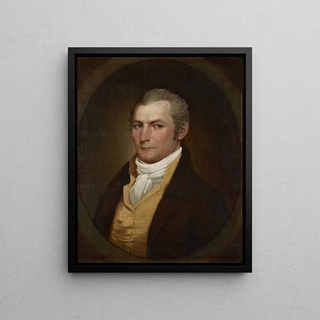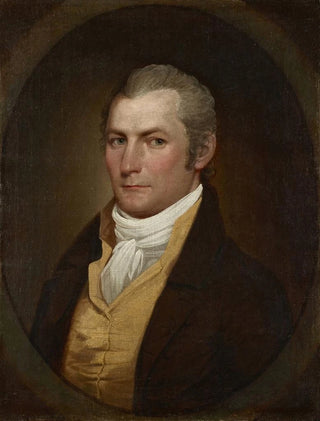Art print | Portrait of a man - John Trumbull


View from behind

Frame (optional)
In the fascinating universe of art, some works transcend their era to capture the very essence of humanity. "Portrait of a man" by John Trumbull is one of those creations that, through its striking realism and psychological depth, invites the viewer to reflect on individuality and character. This portrait, which seems to come alive before the observer's eyes, embodies a time when art served not only to immortalize historical figures but also to explore the nuances of the human soul. The art print of this iconic piece allows appreciation of Trumbull's virtuosity while offering a window into the history and values of his time.
Style and uniqueness of the work
John Trumbull's style is deeply rooted in the neoclassical movement, but he stands out with a unique approach that combines academic rigor and personal sensitivity. In "Portrait of a man," every detail is meticulously rendered, from the folds of the clothing to the facial expressions. The light, skillfully orchestrated, sculpts the features of the subject, revealing an emotional intensity that transcends mere physical representation. This art print does not merely depict an individual; it tells a story, evokes a complex personality, and engages the viewer in a silent dialogue. The color palette, subtle and nuanced, helps create an atmosphere that is both intimate and majestic, making this work a true masterpiece of artistic expression.
The artist and his influence
John Trumbull, born in 1756, is often considered the official painter of the American Revolution. His artistic journey is marked by a desire to capture the spirit of his time, and his works testify to a deep understanding of history and human psychology. Trumbull was able, through his portraits, to immortalize emblematic figures of his era, while leaving an indelible mark on the American artistic landscape. His influence goes beyond mere technique; he paved the way for a new way of perceiving the portrait, where the individual is presented in all their complexity. By paying tribute to historical personalities, he also contributed to forging a national identity, making his works symbols of pride.

Matte finish

View from behind

Frame (optional)
In the fascinating universe of art, some works transcend their era to capture the very essence of humanity. "Portrait of a man" by John Trumbull is one of those creations that, through its striking realism and psychological depth, invites the viewer to reflect on individuality and character. This portrait, which seems to come alive before the observer's eyes, embodies a time when art served not only to immortalize historical figures but also to explore the nuances of the human soul. The art print of this iconic piece allows appreciation of Trumbull's virtuosity while offering a window into the history and values of his time.
Style and uniqueness of the work
John Trumbull's style is deeply rooted in the neoclassical movement, but he stands out with a unique approach that combines academic rigor and personal sensitivity. In "Portrait of a man," every detail is meticulously rendered, from the folds of the clothing to the facial expressions. The light, skillfully orchestrated, sculpts the features of the subject, revealing an emotional intensity that transcends mere physical representation. This art print does not merely depict an individual; it tells a story, evokes a complex personality, and engages the viewer in a silent dialogue. The color palette, subtle and nuanced, helps create an atmosphere that is both intimate and majestic, making this work a true masterpiece of artistic expression.
The artist and his influence
John Trumbull, born in 1756, is often considered the official painter of the American Revolution. His artistic journey is marked by a desire to capture the spirit of his time, and his works testify to a deep understanding of history and human psychology. Trumbull was able, through his portraits, to immortalize emblematic figures of his era, while leaving an indelible mark on the American artistic landscape. His influence goes beyond mere technique; he paved the way for a new way of perceiving the portrait, where the individual is presented in all their complexity. By paying tribute to historical personalities, he also contributed to forging a national identity, making his works symbols of pride.






